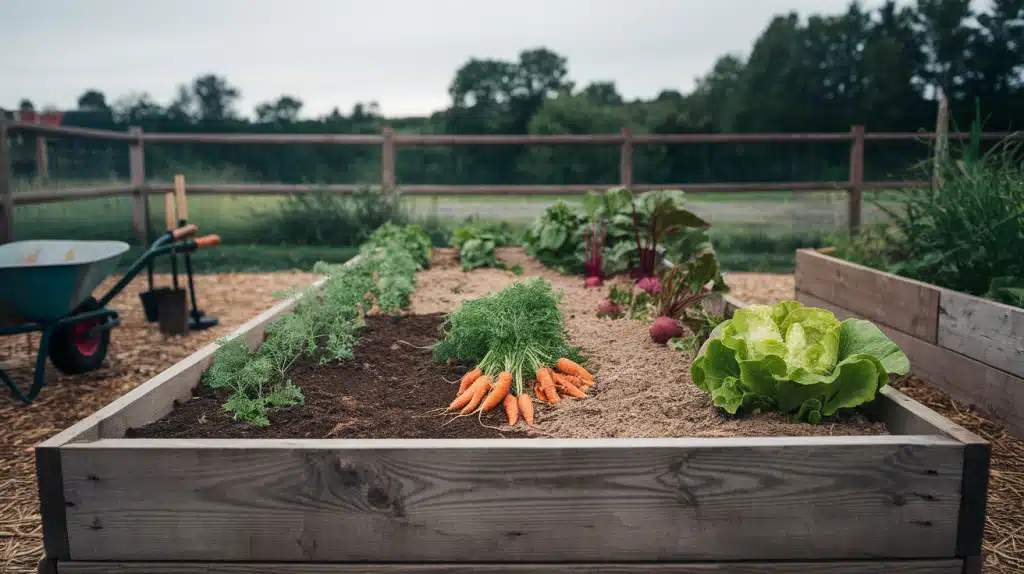Want to start a garden without spending too much? Raised garden beds offer a smart solution for growing your food. We’ll show you how to fill these beds wisely, using materials that work well and cost less.
Filling a raised bed doesn’t mean emptying your wallet. Simple items like old logs, yard waste, and homemade compost can create perfect growing spaces. This guide walks you through proven methods that help your plants and your budget.
You’ll learn three key filling techniques, plus tips to keep your garden healthy year-round. Most materials you need might already be in your yard. Ready to build your garden? Let’s look at how to do it right while keeping costs down.
Getting to Know Raised Garden Beds
Raised garden beds offer practical benefits for both new and experienced gardeners. Let’s examine why they work so well and how to fill them properly.
Why Opt for Raised Beds?
Growing plants in raised beds makes gardening easier and more effective. These beds lift the soil above ground level, which improves water and airflow.
Your back will thank you, too. The higher soil level means less bending and stretching while you plant, weed, or harvest. Many gardeners find they can work longer and more comfortably with raised beds.
With raised beds, you can be the boss of your soil. Want to grow tomatoes? Add extra calcium. Need better drainage? Add more sand. You can adjust the soil mix to match what your plants need.
The Crucial Role of Proper Bed Filling
The way you fill your raised bed shapes how well your plants grow. Good filling creates spaces for roots to spread and find water. Poor filling can lead to wet, heavy soil that makes roots struggle.
Think of bed filling as building a foundation for your garden’s future. When done well, it helps:
- Keep soil loose and healthy
- Feed plants steadily over time
- Hold water without getting soggy
- Support strong root growth
Step-by-Step Guide to Economically Filling a Raised Garden Bed
1. Select a Convenient Raised Bed
Start with a metal raised bed that stands waist-high. This height makes gardening comfortable for everyone. Metal beds last longer than wood and need less upkeep over time.
2. Base Layer of Logs
Begin filling with old logs at the bottom. Choose logs that feel light and show signs of breaking down. These logs:
- Hold moisture like a sponge
- Break down slowly to feed plants
- Create spaces for helpful soil creatures
- Save money by using less soil
3. Add Smaller Organic Materials
Place dry twigs and small branches on top of the logs. Make sure they’re fully dried out first. Wet materials might rot too fast and cause the soil to sink.
4. Install a Buffer Layer
Add old plant matter, like dried vines, as your next layer. This material fills gaps between bigger pieces and helps water move through the bed. It works like a bridge between rough materials below and soil above.
5. Fill with Soil
Mix in basic soil or ready compost next. Leave about 15 inches of space at the top. This layer:
- It gives roots room to grow
- It helps water move evenly
- Keeps costs down
- Uses materials you might already have
6. Top with High-Quality Soil
Add good garden soil as the final layer. Mix in some plant food if you can. This top layer is where most roots will grow, so it needs the best care.
7. Adjust Soil Level as Needed
Watch how the soil settles after watering. Add more if needed. The soil will naturally pack down over time.
8. Optional Enhancements
Think about adding:
- A water system that drips slowly
- A layer of mulch to keep moisture in
- Extra compost each growing season
Video Tutorial
Watch a full YouTube video tutorial on how to fill a raised garden bed cheaply:
Raising Garden Bed Expenses and Budgeting Considerations
| Material | Average Cost | Quantity Needed | Total Cost | Budgeting Tips |
|---|---|---|---|---|
| Topsoil | $20-$30 per cubic yard | Three cubic yards (for a standard 4×8 bed) | $60-$90 | Compare prices at different suppliers; consider bulk purchases to reduce costs. |
| Compost | $15-$25 per cubic yard | One cubic yard | $15-$25 | Mix with cheaper materials like leaf mold to extend volume without compromising nutrient quality. |
| Wood Chips | Free-$10 per cubic yard | Two cubic yards | $0-$20 | Check for free community programs offering wood chips or buy in bulk during off-season sales. |
| Leaf Mold | Free | Two cubic yards | $0 | Collect leaves in fall and compost to create leaf mold, a free and nutrient-rich material. |
| Gravel for Drainage | $5-$20 per cubic yard | 0.5 cubic yards | $2.50-$10 | Purchase from construction sites or landscape suppliers that offer bulk rates. |
| Manure | Free-$10 per cubic yard | One cubic yard | $0-$10 | If available, source directly from local farms to save costs or even get for free. |
| Straw Bales | $5-$10 per bale | Two bales | $10-$20 | Buy from local farmers after the harvest season when prices are lower. |
Maintaining Your Economical Raised Bed
1. Spring Care
Start fresh as winter ends. Mix one inch of compost into the top soil layer. This feeds your plants without costly items. Look at soil levels – they should sit two inches below the bed’s rim.
A simple pH test helps you know what your soil needs. Many garden stores offer free testing. Add basic plant food now to feed crops all season.
2. Summer Tasks
Use grass clippings as mulch to keep costs low. This holds water and stops weeds. Check moisture by pushing your finger into the soil—it should feel like a damp sponge.
Pull weeds while they’re small. This free task saves money on weed tools. Fill empty spots with saved compost from your bin.
3. Fall Work
Test your soil before winter comes. Many local farm offices do this for free. Save fallen leaves – they’re free garden gold. Store them dry for spring use.
Plant basic cover crops like clover. These plants keep the soil healthy through winter. Use simple cloth covers to protect your beds from harsh weather.
4. Winter Planning
Make a list of what you’ll need for spring. This helps avoid costly rush purchases. Watch how soil levels change during freeze-thaw cycles.
Keep collecting kitchen scraps for next year’s compost. Check your bed’s sides for any damage that needs fixing.
5. Money-Smart Tips
- Build a basic compost bin from old pallets
- Share garden tools with nearby growers
- Keep seeds from your best plants
- Trade extra supplies with other gardeners
- Look for free materials in your area
6. Long-Term Success
Good care now saves money later. Small, regular fixes prevent big, costly problems. Your raised bed will last longer and grow better with steady attention.
Other Budget-Friendly Methods to Consider
| Method | Description | Materials Needed | Benefits | Drawbacks/Tips |
|---|---|---|---|---|
| Hugelkultur | Permaculture technique using decomposing wood as a base | Logs, branches, leaves, soil | Water retention, slow-release nutrients | Initial setup labor-intensive; settling over time |
| Lasagna Gardening | Layering organic materials to create rich soil | Cardboard, green waste (grass clippings), brown waste (leaves), compost | Soil health improvement reduces waste | Requires time for layers to decompose before planting |
| Bulk Buying & Local Resources | Sourcing materials in bulk from local suppliers | Compost, manure, wood chips, topsoil | Reduces costs, supports local economy | Coordination needed; storage space for bulk materials |
Conclusion
Ready to grow more while spending less? These filling methods make gardening easy and budget-friendly. A well-filled raised bed gives back more than it takes—fresh vegetables, bright flowers, and the joy of growing your own food.
Try these tested methods based on what you have and what you need. Start small, learn what works in your space, and build from there. Good soil creates strong plants; you can make that soil without breaking the bank.
Your garden grows better when the foundation stays strong. The techniques we’ve shared help you create that foundation while saving money. Put these ideas to work, and watch your garden thrive season after season.
Start with one method, adapt as needed, and enjoy the results of your smart gardening choices.









